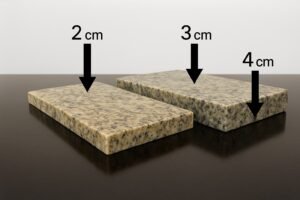When it comes to choosing granite for construction or design projects, thickness matters just as much as color and finish. Granite’s strength, longevity, and aesthetic appeal are heavily influenced by the slab’s thickness — making it critical to select the right one for your specific use.
In this guide, we break down common granite thicknesses and recommend the best fit for various applications.
Common Granite Thicknesses
-
2 cm (20 mm) Granite
-
Standard in many countries for residential countertops and interior wall cladding.
-
Lightweight and easier to install.
-
Requires a plywood backing or additional support for countertops to prevent breakage.
-
Ideal for:
-
Kitchen countertops (with support)
-
Bathroom vanities
-
Wall panels
-
-
-
3 cm (30 mm) Granite
-
Thicker and naturally stronger, often used in premium kitchen countertops and high-traffic areas.
-
No additional substrate needed — it can support itself.
-
Offers a more luxurious and robust appearance.
-
Ideal for:
-
Kitchen islands and countertops
-
Commercial counters
-
Outdoor kitchen tops
-
-
-
4 cm+ (40 mm and above) Granite
-
Mostly custom-ordered for architectural features and high-end projects.
-
Extremely durable and makes a bold visual impact.
-
Ideal for:
-
Stair treads
-
Monumental applications
-
Custom-designed furniture pieces
-
-
Choosing the Right Thickness: Application Guide
| Application | Recommended Thickness | Notes |
|---|---|---|
| Residential Kitchen | 2 cm or 3 cm | 2 cm with support; 3 cm for better durability |
| Commercial Countertops | 3 cm | Handles heavy usage with ease |
| Exterior Cladding | 2 cm | Lightweight and easy to fix |
| Flooring (Indoor/Outdoor) | 2 cm or custom cuts | Depends on foot traffic and setting |
| Staircases | 3 cm or 4 cm | Safety and strength are priorities |
| Table Tops & Furniture | 3 cm or thicker | Enhanced stability and luxury appeal |
Why Thickness Matters
-
Structural Integrity: Thicker granite resists cracking, especially in unsupported spans.
-
Aesthetics: Thicker slabs look richer and more premium.
-
Cost: Thinner slabs are more affordable, but may require extra materials for reinforcement.
-
Installation: Thicker slabs are heavier and may increase labor and transport costs.

